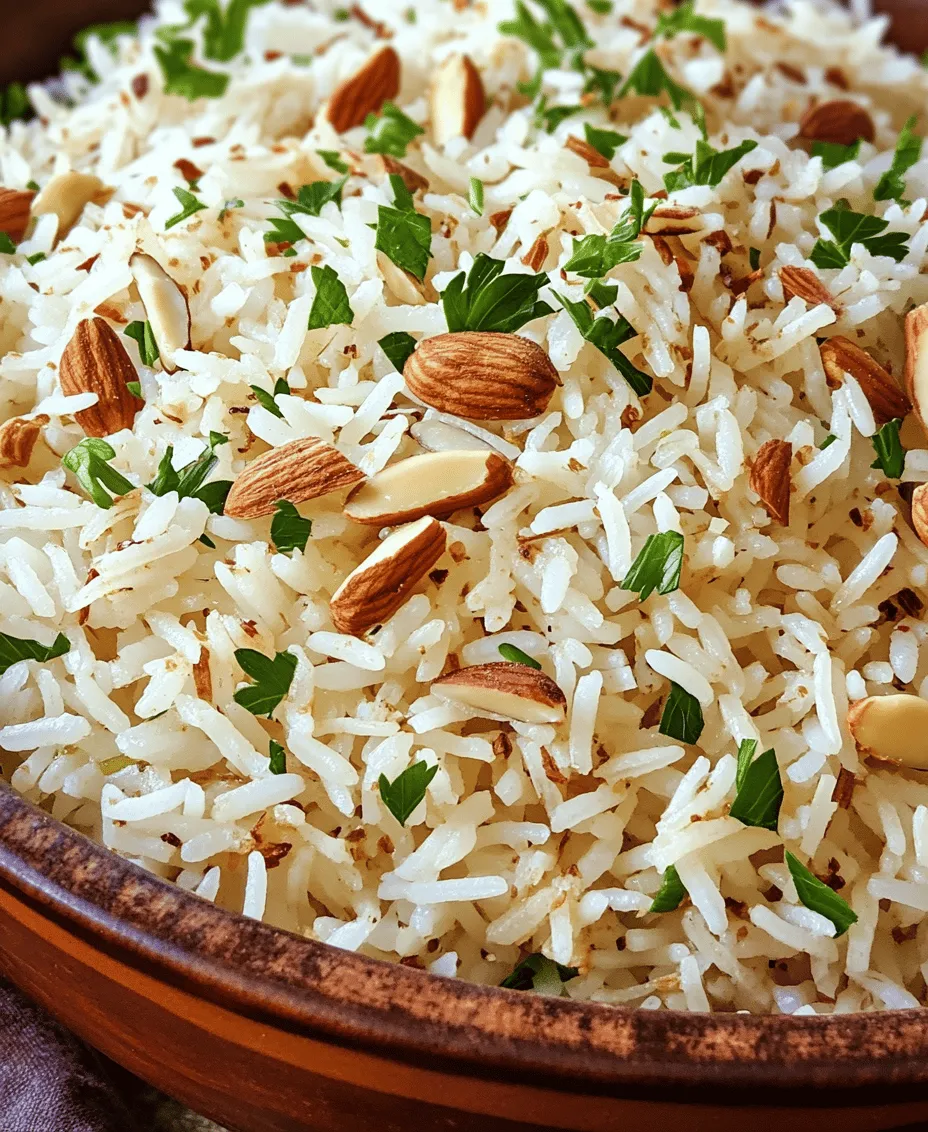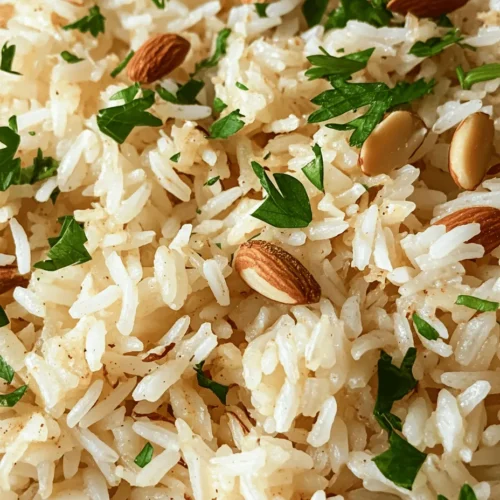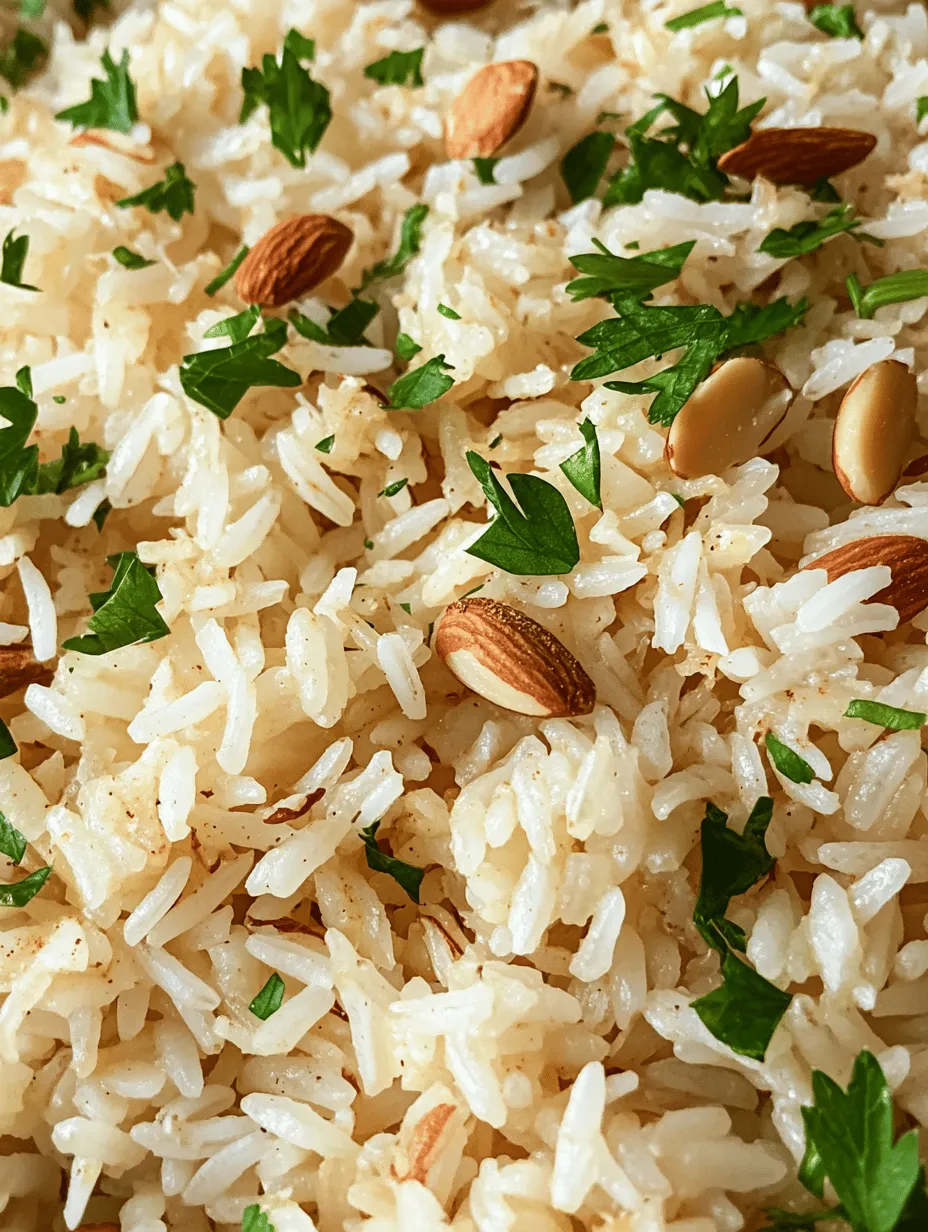Introduction
Lebanese cuisine is a vibrant tapestry woven from a rich history of flavors, traditions, and cultural influences. Renowned for its healthful ingredients and aromatic spices, Lebanese food offers an exquisite dining experience that tantalizes the taste buds. Among the many staples that define this culinary landscape, rice holds a prominent place, serving as the foundation for a variety of dishes and meals. In the Middle East, rice is not just a side dish; it is often the heart of the meal, accompanying everything from grilled meats to savory stews.
One standout recipe that encapsulates the essence of Lebanese cooking is *Aromatic Lebanese Rice with Nuts and Spices*. This dish is a delightful blend of fluffy basmati rice, toasted nuts, and fragrant spices, creating a symphony of flavors and textures that are sure to please any palate. The combination of nutty undertones from the rice and the richness of the nuts, paired with the warm, inviting spices, makes this dish not only a culinary delight but also a celebration of Lebanese culture.
What makes this aromatic rice so appealing is not just its flavor but also its versatility. It can be served as a side dish or a main course, making it perfect for both everyday family dinners and special occasions. Furthermore, its cultural significance cannot be overstated; rice is often a staple at Lebanese gatherings, symbolizing hospitality and abundance.
In this article, we will explore the intricacies of preparing *Aromatic Lebanese Rice with Nuts and Spices*, delving into each ingredient’s role, the cooking techniques that enhance the dish, and the steps to achieve a perfect result.
Understanding the Ingredients
Overview of Basmati Rice
At the heart of this aromatic dish is basmati rice, a long-grain variety that is cherished for its delicate aroma and fluffy texture. Originating from the Himalayan region, basmati rice has a unique nutty flavor and a distinct fragrance that sets it apart from other rice types. Its long grains remain separate when cooked, which is essential for achieving the perfect texture in dishes like *Aromatic Lebanese Rice*.
The choice of basmati rice is particularly important for this recipe, as its light and fluffy nature allows it to absorb flavors from the broth and spices without becoming mushy. Additionally, basmati rice has a lower glycemic index compared to other rice varieties, making it a healthier option for those looking to maintain stable blood sugar levels.
Broth Choices: Chicken vs. Vegetable
When preparing *Aromatic Lebanese Rice*, the choice of broth plays a crucial role in enhancing the dish’s flavor profile. Traditionally, chicken broth is used to infuse the rice with a rich and savory depth. However, for those who prefer a vegetarian or vegan option, vegetable broth can also be utilized effectively.
Chicken broth adds a savory umami quality, making the rice more robust and flavorful. It is typically made by simmering chicken bones with aromatic vegetables like onions, carrots, and celery, resulting in a rich and hearty base. On the other hand, vegetable broth, made from simmering various vegetables and herbs, offers a lighter, yet still flavorful alternative.
Both options bring their own nutritional benefits to the dish. Chicken broth is a source of protein and essential minerals, while vegetable broth is lower in calories and rich in vitamins. Ultimately, the choice between chicken and vegetable broth depends on dietary preferences and desired flavor intensity.
Nuts and Spices: Key Flavor Contributors
The true magic of *Aromatic Lebanese Rice with Nuts and Spices* lies in its delightful combination of nuts and spices. Slivered almonds and pine nuts are the stars of this dish, contributing not only a satisfying crunch but also a wealth of health benefits. Nuts are known for their heart-healthy fats, fiber, and essential nutrients such as vitamin E and magnesium. The inclusion of these nuts not only enhances the texture but also elevates the dish’s nutritional value.
Equally important are the spices that define this Lebanese classic. Cumin, cinnamon, and allspice are the key players that infuse the rice with warmth and depth. Cumin lends a warm, earthy flavor that is often associated with Middle Eastern cuisine, while cinnamon adds a subtle sweetness and aromatic quality that complements the dish beautifully. Allspice, with its unique blend of cinnamon, nutmeg, and clove flavors, rounds out the spice profile, enhancing the overall aroma and taste. Together, these spices create a fragrant medley that transports you straight to the heart of Lebanon.
Step-by-Step Cooking Instructions
Preparing the Rice
The first step in creating perfect *Aromatic Lebanese Rice* is to properly prepare the basmati rice. Rinsing the rice is essential to remove excess starch, which can cause the grains to become sticky during cooking. To rinse the rice, place it in a fine-mesh sieve and run cold water over it until the water runs clear. This process typically takes a few minutes, but it is crucial for achieving fluffy rice.
After rinsing, it is beneficial to soak the basmati rice for at least 30 minutes. Soaking allows the grains to absorb water, which helps them cook evenly and results in a better texture. Once soaked, drain the rice and set it aside while you prepare the remaining ingredients.
Sautéing the Aromatics
Sautéing the aromatics is the next step in this flavorful journey. Start by heating a generous amount of olive oil or butter in a large saucepan over medium heat. Once the oil is shimmering, add finely chopped onions and minced garlic. The goal is to sauté these ingredients until the onions become translucent and slightly caramelized, releasing their natural sweetness. This step is crucial, as it forms the flavor base of the dish.
To achieve the right level of sweetness in the onions, avoid high heat, which can cause them to brown too quickly without developing their flavor. Instead, allow them to cook slowly, stirring occasionally to ensure even cooking. After about 5-7 minutes, once the onions are soft and fragrant, proceed to the next step.
Toasting the Nuts
Toasting the nuts is an essential technique that enhances their flavor and adds a delightful crunch to the rice. In a separate dry skillet over medium heat, add the slivered almonds and pine nuts. Stir them frequently for about 3-5 minutes until they are golden brown and fragrant. Be careful not to burn them, as nuts can go from perfectly toasted to burnt in a matter of seconds.
The toasting process brings out the natural oils in the nuts, intensifying their flavor and adding a lovely nuttiness to the dish. Once toasted, remove them from the skillet and set them aside to cool slightly before incorporating them into the rice.
Combining Ingredients
Now that the rice, aromatics, and toasted nuts are ready, it’s time to bring everything together. In the same saucepan with the sautéed onions and garlic, add the rinsed and soaked basmati rice. Gently stir the rice to coat it with the oil and aromatics, allowing each grain to soak in the flavors.
Next, add the toasted nuts and the selected broth (chicken or vegetable) to the saucepan. The broth should be heated and added in a 1:1.5 ratio with the rice; for every cup of rice, you will need 1.5 cups of broth. This ratio ensures the rice absorbs the right amount of liquid for perfect cooking.
Sprinkle in the spices—cumin, cinnamon, and allspice—mixing thoroughly to ensure they are evenly distributed throughout the rice. The aromatic blend of spices will begin to permeate the dish, creating an inviting fragrance that fills your kitchen.
As you prepare to cook the rice, bring the mixture to a gentle boil, then reduce the heat to low, cover the saucepan with a tight-fitting lid, and allow the rice to simmer. The cooking process typically takes about 15-20 minutes, during which the rice will absorb the flavors of the broth and spices while becoming tender and fluffy.
By following these steps, you will have set the foundation for a delicious and aromatic Lebanese rice dish that celebrates the rich culinary heritage of Lebanon. The balance of flavors, textures, and aromas will come together beautifully, making it a perfect accompaniment to any meal or a delightful centerpiece on its own.
Stay tuned for the next part of this recipe, where we will explore additional tips for best results and answer common questions about preparing this delightful dish.

Importance of Seasoning at This Stage
Seasoning is a crucial step in the preparation of Aromatic Lebanese Rice with Nuts and Spices. The right balance of spices can elevate the dish from ordinary to extraordinary, enhancing not just the flavor but also the overall dining experience. At this stage, consider adding salt to the water before cooking the rice. A well-seasoned cooking liquid allows the rice to absorb flavor as it cooks, creating a more harmonious final dish.
Don’t hesitate to experiment with spices beyond the traditional cinnamon and allspice. A hint of saffron can introduce a luxurious depth, while a touch of cardamom can provide an aromatic twist. Remember, the goal is to create a rich, flavorful base that complements the nuttiness of the rice and the crunch of the nuts.
Cooking the Rice
Once your spices are selected and your ingredients are prepped, it’s time to cook the rice. Begin by rinsing 2 cups of basmati rice under cold water. This process removes excess starch, preventing the rice from becoming gummy. After rinsing, let the rice soak in water for about 30 minutes. This soaking step not only helps to achieve a softer texture but also ensures that the grains cook evenly.
In a large pot, heat 2 tablespoons of olive oil over medium heat. Add the soaked and drained rice, stirring gently to coat each grain with oil. Sauté the rice for about 2-3 minutes until it becomes slightly translucent. This step is essential as it helps to create a nutty flavor in the rice, which is a hallmark of well-prepared Lebanese rice.
Next, add 4 cups of water to the pot, along with your chosen spices and salt. Bring the mixture to a boil. Once boiling, reduce the heat to low, cover the pot with a tight-fitting lid, and let it simmer.
Techniques for Perfect Simmering
Simmering rice effectively requires patience and attention. The key is to maintain a low and steady heat. If the temperature is too high, the water will evaporate too quickly, leaving the rice undercooked. Conversely, if the heat is too low, the rice may not cook through properly. After the initial boil, reduce the heat and allow the rice to simmer gently for about 15-20 minutes.
During this time, it’s essential not to lift the lid. Lifting the lid releases steam, which is vital for cooking the rice evenly. The trapped steam helps to cook the rice from the top down, ensuring that every grain is fluffy and perfectly cooked.
Understanding the Role of Steam in Cooking Rice
Steam plays a critical role in cooking rice, especially in a dish like Aromatic Lebanese Rice. When the water boils, it turns into steam, which cooks the rice grains. The steam circulates within the pot, allowing the heat to penetrate each grain uniformly. This method prevents the rice from becoming mushy or sticking together.
To check if the rice is done, use a fork to gently fluff the rice from the side of the pot. If it seems too firm, cover it again and allow it to cook for an additional few minutes. The right texture should be tender with each grain separate, embodying the hallmark of perfectly cooked basmati rice.
Finishing Touches
Once the rice is cooked to perfection, remove the pot from heat and let it rest, covered, for about 10 minutes. This resting period is vital as it allows the rice to steam further, enhancing its texture. During this time, prepare the finishing touches.
In a small skillet, toast 1 cup of mixed nuts (such as almonds, pine nuts, and walnuts) over medium heat until golden brown and fragrant, being careful not to burn them. This step adds both flavor and a delightful crunch to the dish. Once toasted, remove the nuts from the heat, and mix them into the rice along with a handful of freshly chopped parsley for a burst of color and freshness.
Techniques for Fluffing Rice
After the resting period, it’s time to fluff the rice. Using a fork, gently separate the grains by lifting them from the bottom of the pot and letting them fall back down. This technique aerates the rice, preventing it from becoming dense or sticky. Be gentle to avoid breaking the grains, and ensure that the nuts and herbs are well-distributed throughout.
Serving Suggestions
Presentation Ideas for Lebanese Rice
When it comes to presenting your Aromatic Lebanese Rice with Nuts and Spices, a beautiful display can enhance the overall dining experience. Serve the rice in a large, shallow dish to showcase the colorful nuts and herbs. Consider layering the rice with a sprinkle of toasted nuts on top, creating an inviting presentation.
Suggestions for Garnishing with Fresh Parsley
A garnish of fresh parsley not only adds a pop of color but also contributes a fresh flavor that balances the richness of the nuts and spices. Chop the parsley finely and sprinkle it generously over the top of the rice before serving. For added flair, you can also add pomegranate seeds, which provide a delightful burst of sweetness and a beautiful contrast to the dish.
How to Serve Alongside Traditional Lebanese Dishes
Aromatic Lebanese Rice pairs beautifully with a variety of traditional Lebanese dishes. It serves as an excellent side to grilled meats, such as kebabs or shawarma, and complements rich stews like lamb tagine. Consider serving it alongside a fresh tabbouleh salad or a tangy fattoush to create a well-rounded meal.
Pairing Options
Complementary Dishes that Enhance the Meal
To round out your Lebanese feast, consider serving your rice with a selection of meze (appetizers) such as hummus, baba ghanoush, or stuffed grape leaves. These dishes provide a variety of flavors and textures that enhance the overall dining experience.
Recommended Beverages to Accompany the Dish
For beverages, consider serving Lebanese red wine or a refreshing mint lemonade. These drinks not only complement the flavors of the rice but also add to the cultural authenticity of the meal. Alternatively, a chilled ayran (yogurt drink) can provide a cooling contrast to the spices in the rice.
Nutritional Benefits
Overview of the Health Benefits of the Main Ingredients
Aromatic Lebanese Rice with Nuts and Spices is not just a delicious dish; it is also packed with nutritional benefits. Basmati rice is a great source of carbohydrates, providing energy and essential nutrients. The nuts add healthy fats, protein, and fiber, making this dish satiating and nutritious.
Nutritional Profile of Basmati Rice
Basmati rice is known for its low glycemic index, making it a suitable option for those watching their blood sugar levels. It is gluten-free and rich in vitamins and minerals, including B vitamins, iron, and magnesium. The aromatic nature of basmati rice is also attributed to its essential oils, which contribute to digestion and overall health.
Benefits of Nuts and Spices for Heart Health and Metabolism
The combination of nuts and spices not only enhances the flavor profile but also offers significant health benefits. Nuts are known to support heart health due to their high levels of unsaturated fats and antioxidants. Spices like cinnamon and allspice are recognized for their anti-inflammatory properties and potential metabolic benefits.
How This Dish Fits into a Balanced Diet
This dish fits well into a balanced diet, providing a mix of carbohydrates, proteins, and healthy fats. For those following vegetarian or vegan diets, it offers a wholesome meal option that is both filling and nourishing.
Considerations for Vegetarian and Vegan Diets
Aromatic Lebanese Rice with Nuts and Spices is an excellent choice for vegetarians and vegans alike. It can easily serve as the main component of a meal when paired with vegetables, legumes, or plant-based proteins. The rich flavors and textures make it a satisfying dish that can stand alone or complement a variety of other vegetarian offerings.
Cultural Context
Historical Significance of Rice in Lebanese Cuisine
Rice holds a significant place in Lebanese cuisine, often serving as a foundation for many traditional dishes. Its versatility allows it to be paired with a wide range of ingredients, from meats and vegetables to nuts and spices. Historical trade routes through Lebanon introduced diverse spices and cooking techniques, enriching the culinary landscape.
Exploration of Regional Variations in Rice Dishes
Different regions of Lebanon have their unique takes on rice dishes, often influenced by local ingredients and traditions. For instance, some areas may incorporate saffron or dried fruits like raisins and apricots, while others may focus on savory flavors. These variations reflect the rich cultural tapestry that defines Lebanese cuisine.
The Role of This Dish in Lebanese Celebrations and Gatherings
Aromatic Lebanese Rice with Nuts and Spices is often served during celebrations and family gatherings, symbolizing hospitality and abundance. It is a staple at festive occasions such as weddings, holidays, and communal meals, where it brings people together around the table.
Personal Stories or Anecdotes About Enjoying the Dish
Many families have personal stories tied to this dish, often recalling memories of cooking together or sharing meals during special occasions. Whether it’s a cherished family recipe passed down through generations or a modern twist on a classic, Aromatic Lebanese Rice evokes a sense of nostalgia and connection to cultural heritage.
Conclusion
Aromatic Lebanese Rice with Nuts and Spices is more than just a dish; it is a culinary journey that encapsulates the essence of Lebanese cuisine. Its rich flavors, nutritional benefits, and cultural significance make it a worthy addition to any meal. As you explore this recipe, consider delving deeper into the diverse world of Lebanese cooking. Embrace the opportunity to incorporate diverse flavors into your everyday meals, celebrating the vibrant traditions that food can offer. Whether enjoyed at a family gathering or as a comforting weeknight dinner, this rice dish invites you to savor every moment at the table.



